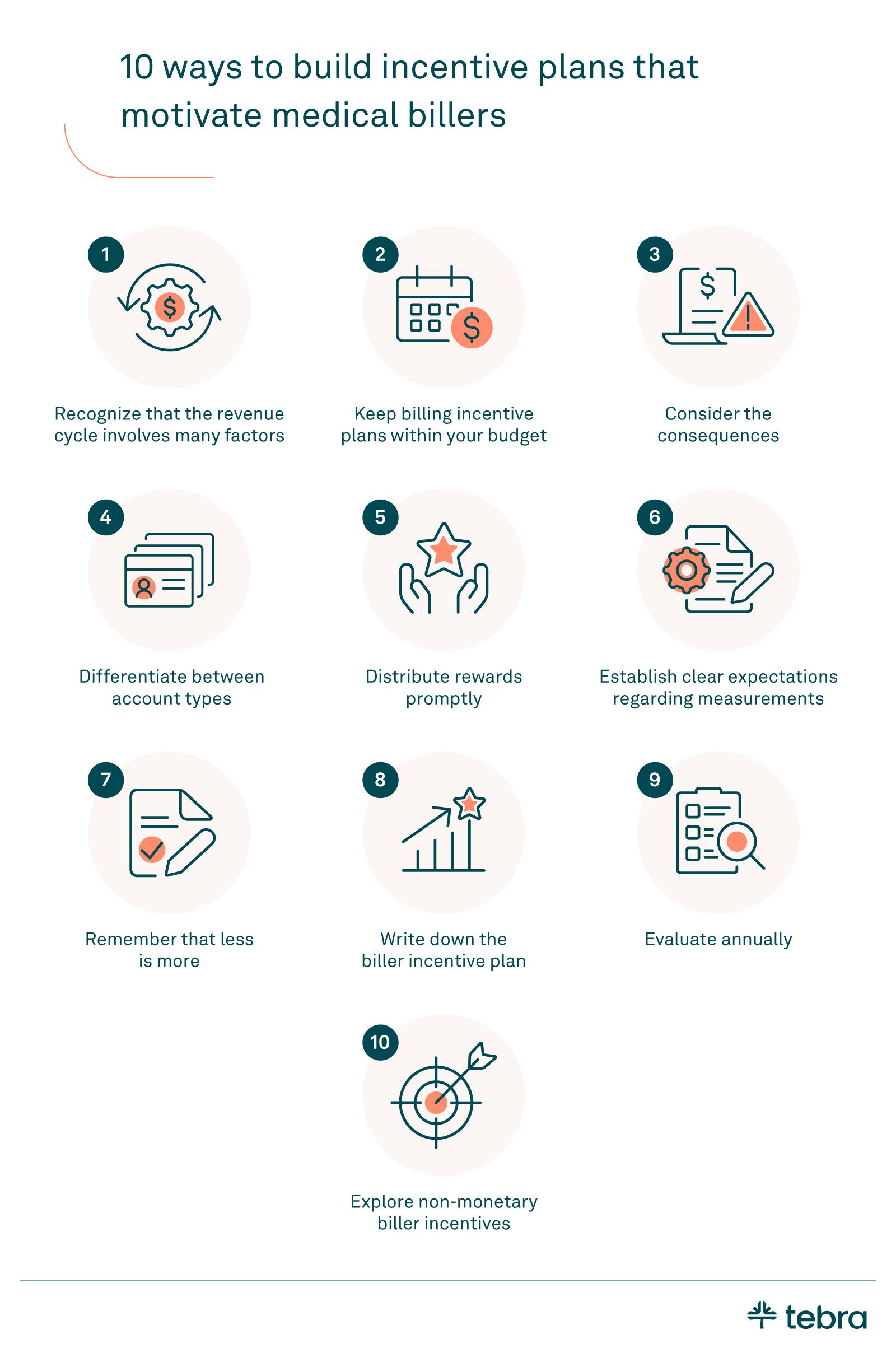
- Focus on specific, measurable results instead of fixed, unchanging goals. Align incentives with your financial plans and revenue cycle management (RCM) KPIs.
- Design for the full revenue cycle management process. Cap individual rewards to keep plans sustainable, and watch for side effects that increase claim denials.
- Tailor goals by payer type and specialty. Verify eligibility, define clear measurements, pay out promptly, and review regularly to strengthen cash flow and accounts receivable.
Effective performance incentive plans motivate employees without straining your organization's resources. Incentives should fit your budget and tie to specific results, while you consider the plan's design, goals, and timing.
When performance goals align with medical billing and revenue cycle management workflows, they help reinforce automation, improve patient care and satisfaction, and reflect both organizational priorities and current industry trends.

Define performance goals for medical billers
Performance goals for medical billers should focus on accuracy, efficiency, and compliance to optimize revenue cycle management. Key objectives include reducing claim denial rates through thorough eligibility verification, staying current with payer requirements, and streamlining processing workflows while maintaining coding accuracy and participating in ongoing professional development.
These performance goals for medical billers connect to KPIs (key performance indicators) in your EHR and billing systems, guiding revenue teams and each payer to cut the denial rate through eligibility checks and accurate CPT/ICD-10 coding for compliance and to optimize results.
Use the following 10 tips to turn these goals and key performance indicators into daily actions across your revenue cycle management team.
Download your free resource now
Access it instantly — just complete the form

1. Recognize that the revenue cycle involves many factors
Medical billing is an operational process, not a desk or a department. Your incentive plan should recognize that everyone in the organization plays a role in that process. For instance, front office staff improve the collection rate when they consistently ask for copayments from every patient who owes one.
Schedulers reduce days in accounts receivable when they collect balances during appointment scheduling. An effective plan ties rewards to clear targets. An example of this would be always verifying eligibility.
As many staff members work in teams, base rewards on both team performance and individual achievement. Doing so will promote collaboration. Strong workflows that capture front-desk insurance information and run real-time eligibility checks in your revenue cycle management tools lower denied claims, protect cash flow, and support accurate ePrescribing in your EHR software.
2. Keep billing incentive plans within your budget
Canceling a popular incentive program can deflate employee morale. Keep your program sustainable by capping individual rewards based on your budget. For example, $100 per month.
Tie rewards to KPIs using clear metrics and benchmarks like days in accounts receivable rather than volume to keep targets fair and achievable. While there may be exceptions, even $25 or $50 a month is appreciated and helps protect cash flow.
3. Consider the consequences
Your incentives might inspire a range of unintended consequences. For instance, if you reward a biller for correcting claim errors faster, denial rates can rise if they skip important steps for the sake of speed.
If you reward resolving all denied claims within 30 days, make sure staff are not reclassifying claims denied for missing documentation, unbundling, medical necessity, or other noncontractual adjustments just to hit the goal.
Most employees are conscientious and will follow the incentives you set. Always weigh the benefits against the pitfalls. Add a safeguard that balances speed with coding compliance and payer policy so you avoid claim denials and hidden inefficiencies in your billing processes.
4. Differentiate between account types
Many organizations assign accounts to billers based on the payer. That approach builds core knowledge but can create discrepancies in incentives. For example, setting the same standards for Medicaid and Medicare accounts may not be equitable. How long claims remain in accounts receivable and their complexity, can also vary by specialty and day-to-day workflows.
Before you implement your incentive plan, work with employees to weigh payers, using Medicare as the benchmark. In many states, Medicaid can take roughly double the resources and time, and workers' compensation may take triple.
Tailor performance goals to payer types, such as 25 days outstanding for Medicare and 50 for Medicaid, and be ready to revise as systems or your payer mix evolve. Set clear RCM benchmarks for days in A/R, denial handling, and documentation so each specialty's workflows are judged fairly.
5. Distribute rewards promptly
Keep incentives closely tied to performance by distributing rewards within 30 days of the monitoring period. Prompt rewards are more effective at reinforcing good outcomes than later ones. For taxable monetary rewards, it is often easiest to include them with regular paychecks.
Provide a separate statement with the pre-tax amount so employees understand earnings before deductions. Set SMART goals with clear KPIs, track results in near real time, and schedule monthly follow-up reviews to reinforce expectations and maintain momentum.
6. Establish clear expectations regarding measurements
An effective incentive program is understandable and easy to track. If the plan is too complex, billers may lose sight of the goal and question its fairness:
- Define the measures and formulas clearly so employees can work toward the intended outcomes.
- Build healthy competition by sharing progress charts and results in staff meetings.
- Track key performance indicators in the EHR and billing dashboard.
- Surface real-time health information that medical coders need for accurate medical billing and coding.
7. Remember that less is more
Smaller rewards, such as $25 to $50 per month, can be impactful. Ask billers to suggest reward amounts. You may be surprised at the modest figures they consider worthy.
Keep incentive criteria short and clear so everyone knows what success looks like. Focus on 3 to 5 KPIs, such as denial rate, collection rate, and days in accounts receivable.
8. Write down the biller incentive plan
It sounds obvious, but write down your plan and make it easy to find. Distribute copies when you announce it by email or on your internal hub. Document goal-setting criteria, note process workflows, and keep audit trails to support compliance.
9. Evaluate annually
Review your incentive plan's results against its intended performance goals each year. Where possible, quantify impact, such as the monetary value of reduced denials from in-house errors. Compare outcomes to benchmarks and current industry trends in RCM.
If the data reveals persistent inefficiencies, consider outsourcing select functions or strengthening your in-house team, and aligning tools with billing and payments. Once you reach a goal, such as collecting all patient copayments at the time of service, move on to the next objective.
10. Explore non-monetary biller incentives
Financial rewards can shift from motivation to expectation. Keep monetary plans short, three to six months, and add non-monetary options that feel timely and sincere. Support professional development with AAPC courses and ongoing CPT and ICD-10 education to reduce denied claims and keep skills current.
Try these ideas to reward billers for reaching goals:
- Public recognition: Announce achievements and give a simple certificate or a shared trophy.
- Small treats: Offer popcorn, movie passes, or a handwritten note that says thank you.
- Gift cards: Provide a local restaurant card and avoid after-hours requests during that week so that the person has the opportunity to use it sooner rather than later.
- Team lunch: Celebrate collective milestones together.
- Flexible time: Allow a late start, early finish, or an extended personal lunch.
- Casual Friday: Relax the dress code to mark a strong month.
Choose options that fit your management style and workplace culture. And don't forget to include your remote staff with incentives like team trivia or a virtual scavenger hunt. Sometimes, the simplest reward is what matters the most.
Say "thank you" to billers. Take time to send a thank-you note, and do it often.

Bring incentives back to patient care
Align incentives with daily work so your medical practice can streamline billing, speed patient payments, and reduce data entry errors. To keep track of all your goals with insurance companies and billers, as well as manage KPIs in one place, Explore Tebra's EHR, billing, and scheduling platform today.
FAQs
FAQs about performance goals for medical billers
You might also be interested in
Learn how to create a seamless patient experience that increases loyalty and reduces churn, while providing personalized care that drives practice growth in Tebra’s free guide to optimizing your practice.
- Current Version – Oct 28, 2025Written by: Jean LeeChanges: This article was updated to include the most relevant and up-to-date information available.






